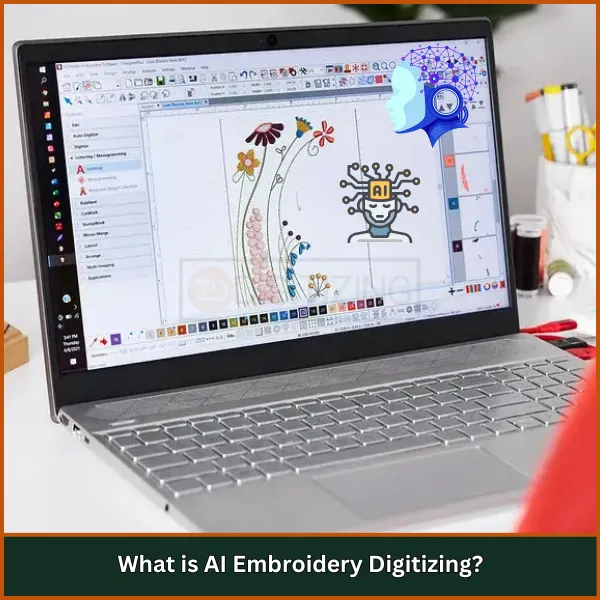How AI Is Transforming Embroidery Digitizing for the Future
Introduction
The world of embroidery has come a long way from hand-stitching and mechanical machines. Today, designers are stepping into an era where artificial intelligence (AI) meets embroidery digitizing, creating an intersection of art and automation. While embroidery digitizing itself revolutionized the textile industry decades ago, the next wave of innovation—powered by AI—is promising to redefine what’s possible in custom apparel and branding.
This article delves into how AI-driven technologies are reshaping the landscape of embroidery digitizing, from intelligent design recommendations to fully automated digitization pipelines. Whether you’re an apparel brand, digitizing business, or freelance embroidery artist, the insights shared here will help you stay ahead of the curve.
What Is Embroidery Digitizing?
Embroidery digitizing is the process of converting artwork or logos into a digital stitch file that an embroidery machine can read. This file contains specific instructions like stitch types, directions, densities, and thread colors.
Traditionally, embroidery digitizing requires skilled professionals and intricate manual input. But with the rise of AI, this labor-intensive process is becoming faster, smarter, and far more scalable.
How AI Is Revolutionizing Embroidery Digitizing
1. Pattern Recognition and Auto-Digitization
AI algorithms can now analyze raster images (e.g., JPEG, PNG) and vector art to automatically identify borders, fill areas, and assign stitch types. This reduces the need for manual plotting of stitch paths.
2. Enhanced Accuracy and Consistency
Machine learning models are trained on thousands of embroidery files to learn ideal stitch types for fabric types, shapes, and image resolutions. This leads to greater accuracy and uniformity.
3. Smart Recommendations
Just as design software suggests color palettes, AI can now recommend stitch types, densities, and underlay structures based on the uploaded design.
4. Adaptive Learning
With every file processed, AI models can learn and improve. Designers and digitizers benefit from systems that get smarter over time.
5. Reduced Turnaround Time
AI eliminates hours of manual work. What used to take 2–3 hours can now be done in under 15 minutes with minimal revisions.
Applications of AI in Embroidery Digitizing
For Apparel Brands
- Quick digitizing for seasonal collections
- Faster prototyping
- Cost-effective production scaling
For Freelancers & Creatives
- AI tools lower the barrier to entry
- More time to focus on creativity rather than technicalities
- Instant edits and automation
For Digitizing Agencies
- Increased volume handling
- Quality assurance using AI checks
- Automatic customer personalization (name, number, logo switch)
Top AI-Enabled Embroidery Digitizing Tools
Here are a few examples of platforms utilizing AI in embroidery digitizing:
- StitchAI Pro – auto-digitizes vector art with 90% accuracy.
- ThreadMind – intelligent fabric-type recommendation engine.
- EZDigitize AI – beginner-friendly with drag-and-drop features.
- DesignPilot.ai – generates embroidery designs from text prompts.
Benefits of Using AI in Embroidery Digitizing
- Faster Workflow: Eliminate bottlenecks in design conversion.
- Error Reduction: Minimized manual errors.
- Cost-Efficiency: Reduced human resources and editing time.
- Scalability: Easily handle bulk orders without sacrificing quality.
- Innovation: Unique design opportunities like morphing logos or animated stitch previews.
Challenges to Consider
- Learning Curve: Adopting AI tools still requires basic digitizing knowledge.
- Over-Reliance: Total automation may lead to generic-looking designs.
- Quality Control: AI isn’t perfect—human review is still essential.
Tips for Designers to Leverage AI in Embroidery
- Start with High-Resolution Art – AI performs best when it has clean data.
- Know Your Fabrics – Some AI tools allow you to set parameters.
- Combine AI with Manual Touch – Let AI handle bulk work, and refine with your skill.
- Stay Updated – AI tools evolve rapidly; keep exploring new features.
The Future of AI in Embroidery Digitizing
Looking ahead, we can expect AI to:
- Generate 3D stitch simulations
- Offer voice-command digitizing
- Provide real-time machine calibration suggestions
- Enable NFT to embroidery conversions
As AI continues to evolve, so too will the creative and commercial possibilities for embroidery digitizing.
Conclusion
Embroidery digitizing is no longer just a technical task—it’s becoming a creative collaboration between human expertise and artificial intelligence. For designers, digitizing experts, and brands, the fusion of AI opens up faster workflows, more accurate stitching, and exciting innovation.
By embracing AI-powered embroidery digitizing, you’re not only staying ahead—you’re threading the future.
FAQs
Q1. Is AI-powered embroidery digitizing better than manual digitizing?
AI is faster and good for bulk jobs, but for high-detail or specialty work, manual touch is still preferred.
Q2. Can AI handle all types of embroidery?
Not yet. AI works best with standard fabrics and flat designs, but is improving in 3D puff, appliqué, and textured embroidery.
Q3. Is AI embroidery digitizing expensive?
Most tools offer affordable subscription plans. In the long run, AI can reduce production costs.
Q4. Will AI replace digitizers?
No—but it will transform their roles. Digitizers will focus more on quality control, design refinement, and creative exploration.










